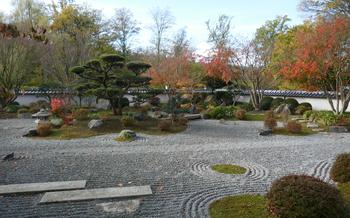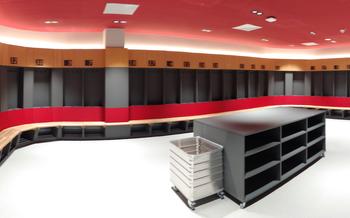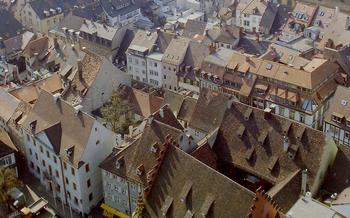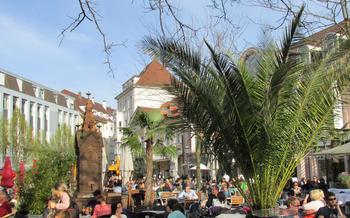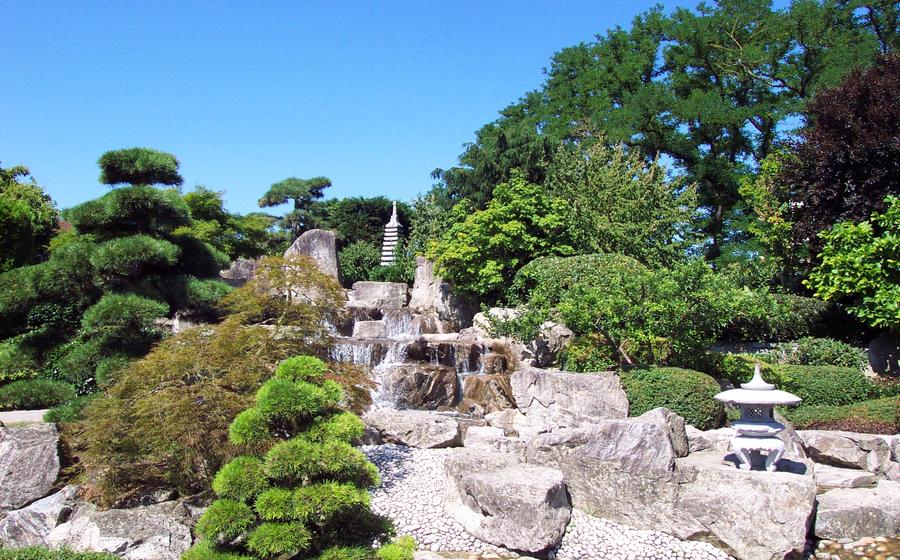
Japanischer Garten (Japanese Garden)
- Freiburg’s Japanese Garden: A Peaceful Haven in the Heart of the Black Forest
- Location and Getting There
- Hours of Operation and Admission fees
- Best Time to Visit
- Things to See and Do
- Paths and Bridges
- Tea House
- Koi Pond
- Hidden Gems and Photo Opportunities
- Educational Programs and Workshops
- Dining and Refreshments
- Souvenir Shopping
- Nearby Attractions
- Accessibility for People with Disabilities
- Tips for Families Traveling with Children
- Photography Tips and Etiquette
- Sustainable Tourism Practices
- Insider Tip: Secret Viewing Spot
Freiburg’s Japanese Garden: A Peaceful Haven in the Heart of the Black Forest
Freiburg's Japanese Garden, nestled in the heart of the Black Forest, is a tranquil oasis that encapsulates the essence of Japanese culture and aesthetics. Its origins can be traced back to 1987 when the city of Freiburg established a sister city relationship with Matsuyama, Japan. As a symbol of this friendship, the Japanese Garden was conceived and designed by renowned Japanese landscape architect Ken Nakajima.
The garden is a testament to traditional Japanese garden design principles, characterized by its harmonious interplay of water, stones, and plants. Meandering paths wind through the serene landscape, leading visitors past tranquil ponds, cascading waterfalls, and meticulously arranged rock formations. Cherry trees, azaleas, and maples provide a vibrant tapestry of colors throughout the seasons, creating a feast for the eyes.
Japanese gardens hold a significant place in Japanese culture, serving as places for contemplation, meditation, and connection with nature. In Freiburg's Japanese Garden, visitors can immerse themselves in the tranquility of the surroundings, escape the hustle and bustle of city life, and find a moment of peace and serenity.
Location and Getting There
The Japanese Garden is conveniently located at Rieselfeldallee 33, 79111 Freiburg im Breisgau. To get there by public transportation, take tram line 1 or 5 to the "Japanischer Garten" stop, which is right outside the garden's entrance. Alternatively, you can take bus line 35 to the "Rieselfeld Süd" stop and walk a short distance to the garden.
For those arriving by car, there is limited parking available at the garden's entrance. However, it's important to note that parking spaces in Freiburg can be scarce, especially during peak tourist season. Consider using public transportation or a taxi if you have difficulty finding parking.
The Japanese Garden is wheelchair accessible, with ramps and designated parking spaces available for visitors with disabilities. Visitors can also rent wheelchairs at the garden's entrance if needed.
Hours of Operation and Admission fees
The Japanischer Garten in Freiburg is open to the public year-round, but the hours of operation vary depending on the season. During the summer months (April to September), the garden is open from 9:00 AM to 8:00 PM, while during the winter months (October to March), it is open from 10:00 AM to 5:00 PM.
Admission fees are charged for all visitors over the age of The standard admission fee for adults is €5, while children and students pay a reduced fee of €There are also discounted rates for families and groups. Visitors with disabilities and their companions are entitled to free admission.
The Japanischer Garten also offers a variety of guided tours in different languages. These tours provide visitors with a deeper understanding of the garden's history, design, and symbolism. Guided tours typically last for about an hour and cost an additional fee.
It is recommended to check the garden's website or contact them directly for the most up-to-date information on hours of operation, admission fees, and guided tours.
Best Time to Visit
The Japanese Garden is a sight to behold throughout the year, but there are certain times when its beauty truly shines. Spring (April-May) is an enchanting season to visit, as the garden bursts into life with vibrant colors. The cherry blossom trees, a symbol of Japan, are in full bloom, painting the landscape with delicate pink and white hues. The air is filled with the sweet fragrance of the blossoms, creating a magical atmosphere.
Autumn (September-October) is another spectacular season to experience the garden. The maple trees transform into a fiery tapestry of red, orange, and yellow, creating a breathtaking contrast to the lush green surroundings. The changing colors of the leaves, known as "koyo", are a celebrated phenomenon in Japanese culture, offering a feast for the eyes.
While the garden is beautiful in all seasons, it is during spring and autumn that its true essence as a place of tranquility and natural beauty can be fully appreciated. Visitors are advised to check the weather forecast before their visit, as the garden is most enjoyable on sunny days.
Things to See and Do
The Japanese Garden in Freiburg is a place of tranquility and beauty, offering visitors a chance to escape the hustle and bustle of city life. The garden is designed to be explored at a leisurely pace, and there are many things to see and do along the way.
Paths and Bridges
A network of paths and bridges winds through the garden, allowing visitors to explore different perspectives and vantage points. The paths are made of gravel, which adds to the natural feel of the garden. The bridges are made of wood and stone, and they offer stunning views of the pond and the surrounding landscape.
Tea House
In the heart of the garden is a traditional Japanese tea house, where visitors can enjoy a cup of tea and traditional Japanese sweets. The tea house is a great place to relax and take in the beauty of the garden.
Koi Pond
The large koi pond is one of the most popular features of the garden. The pond is home to colorful Japanese carp, which are a symbol of good luck and prosperity in Japanese culture. Visitors can feed the koi fish, which is a fun and interactive experience.
Hidden Gems and Photo Opportunities
Beyond the main paths and attractions, Freiburg's Japanese Garden is home to hidden corners and secret spots that offer unique photo opportunities and a chance to escape the crowds. One such hidden gem is the secluded bamboo grove, where visitors can capture the serene beauty of the tall, slender bamboo stalks swaying in the breeze. Another hidden spot is the small waterfall, tucked away among the trees, where the gentle cascade of water creates a tranquil and picturesque scene.
For those seeking the most stunning photo opportunities, the best time to visit the garden is during the cherry blossom season in spring, when the trees burst into a vibrant display of pink and white blossoms. The contrast between the delicate flowers and the dark green foliage creates a breathtaking sight that is sure to capture the hearts of photographers and nature enthusiasts alike.
Autumn is another magical time to visit the garden, when the maple leaves turn vibrant shades of red, orange, and yellow. The reflection of the colorful foliage in the tranquil waters of the pond creates a mesmerizing scene that is perfect for capturing the essence of the Japanese autumn.
Educational Programs and Workshops
The Japanischer Garten in Freiburg is not just a place of beauty but also a center for learning and cultural exchange. The garden offers a variety of educational programs and workshops that allow visitors to delve deeper into the history, design, and symbolism of Japanese gardens.
Guided tours, available in different languages, provide insights into the garden's creation, its significance as a symbol of friendship between Freiburg and Matsuyama, and the principles of Japanese garden design. Visitors can learn about the careful placement of stones, the use of water features, and the symbolism of plants, gaining a deeper appreciation for the garden's aesthetics and cultural significance.
The garden also hosts workshops and classes that offer hands-on experiences related to Japanese culture. Visitors can participate in tea ceremonies, where they learn about the traditional Japanese tea ritual and its associated etiquette. Calligraphy workshops introduce the art of Japanese writing, allowing participants to create their own beautiful characters. Origami classes teach the ancient art of paper folding, allowing visitors to create intricate and delicate paper sculptures.
These educational programs and workshops are an excellent way to enhance your visit to the Japanischer Garten. They provide a deeper understanding of Japanese culture and garden design, creating a more meaningful and memorable experience. Be sure to check the garden's website or inquire at the information center for the schedule of guided tours and workshops during your visit.
Dining and Refreshments
After a tranquil stroll through the Japanese Garden, visitors can satisfy their appetites with a variety of dining options. Within the garden itself, a charming café beckons with a menu of light refreshments and traditional Japanese sweets. Visitors can savor the delicate flavors of matcha tea, accompanied by an assortment of wagashi, or indulge in a refreshing glass of iced tea while soaking in the serene ambiance.
For those seeking a more substantial meal, a short walk from the garden leads to a selection of inviting restaurants. Whether it's a hearty German feast, a taste of international cuisine, or a quick bite to eat, there's something to suit every palate. Many of these establishments offer outdoor seating, allowing visitors to bask in the warmth of the sun while enjoying their meal.
For those who prefer a leisurely picnic amidst the serene beauty of the garden, designated picnic areas provide the perfect setting. Visitors can spread out a blanket, unpack their carefully prepared hampers, and savor a delightful meal surrounded by nature's tranquility. Whether it's a simple lunch of sandwiches and fruit or an elaborate spread of gourmet delicacies, a picnic in the Japanese Garden offers a truly memorable experience.
Souvenir Shopping
Within the garden, you'll find a charming gift shop located near the entrance. This shop is a treasure trove of Japanese-inspired souvenirs, including traditional crafts, delicate ceramics, and unique items that reflect the garden's serene atmosphere. Browse the shelves for exquisite postcards featuring stunning garden scenes, perfect for sending greetings to loved ones back home. Don't miss the opportunity to pick up a commemorative t-shirt or scarf adorned with cherry blossom motifs, a reminder of your visit to this tranquil oasis.
If you're looking for a wider selection of souvenirs, venture into the nearby markets and shops. Freiburg is home to several markets, including the bustling Münstermarkt, where you can find an array of local delicacies, fresh produce, and handcrafted goods. Take your time exploring the stalls, where you can chat with friendly vendors and discover hidden gems like artisanal chocolates, colorful pottery, and hand-carved wooden cuckoo clocks.
Whether you choose to shop within the garden or explore the surrounding markets, you're sure to find unique souvenirs that will serve as lasting mementos of your visit to Freiburg's Japanese Garden.
Nearby Attractions
Freiburg is a city rich in history and culture, and there are many attractions to visit nearby. A must-see is the Freiburg Minster, a stunning Gothic cathedral that dominates the city skyline. Its intricate carvings and stained glass windows are a testament to the skill and artistry of medieval craftsmen.
For a panoramic view of Freiburg and the surrounding countryside, head to Schlossberg, a hill overlooking the city. You can reach the summit on foot, by cable car, or by taking the Schlossbergbahn funicular. Once at the top, you'll be rewarded with breathtaking views of the city, the Black Forest, and the Rhine Valley.
Other nearby attractions include the Augustinermuseum, which houses a collection of medieval and modern art, and the Historical Merchants' Hall, which is now a museum dedicated to the history of trade and commerce in Freiburg.
Accessibility for People with Disabilities
The Japanese Garden in Freiburg is committed to providing an inclusive experience for visitors with disabilities. Wheelchair users can easily navigate the garden's paths and bridges, and designated parking spaces are available near the entrance. Guided tours specifically designed for visitors with disabilities are offered upon request, ensuring that everyone can enjoy the garden's beauty and tranquility. These tours provide detailed descriptions of the garden's features and history, allowing visitors to fully appreciate the serene atmosphere and cultural significance of the Japanese Garden.
Tips for Families Traveling with Children
The Japanischer Garten is a great place for families with children. There are plenty of things to see and do to keep kids entertained and engaged. The garden has a playground with swings, slides, and a sandpit. There are also a number of educational programs and workshops offered throughout the year, such as tea ceremonies and calligraphy classes.
The garden's paths are stroller-friendly, making it easy for parents to navigate with young children. There are also a number of benches and resting spots throughout the garden where families can take a break and enjoy a picnic or a snack.
To make the most of your visit with children, here are a few tips:
- Plan your visit for a time when the garden is less crowded. This will help you avoid long lines and make it easier to get around with a stroller.
- Bring a change of clothes for your children. The garden has a water feature, and it's easy for kids to get wet.
- Pack a picnic lunch or snacks. There is a small café in the garden, but it can be expensive.
- Take your time and explore the garden at your own pace. There's no need to rush, and there's plenty to see and do.
- Encourage your children to ask questions. The garden staff is very knowledgeable and helpful, and they're happy to answer any questions your children may have.
Photography Tips and Etiquette
Capturing the beauty of Freiburg's Japanese Garden through photography is a popular activity among visitors. To ensure a positive experience for all, it's important to follow a few basic photography tips and etiquette guidelines.
Tripod Usage:
Tripods are generally allowed within the garden, but their use should be considerate of other visitors. Avoid setting up tripods in high-traffic areas or blocking paths. Be mindful of others and be willing to move your tripod if necessary.
Respecting Privacy:
When taking photographs, be mindful of other visitors' privacy. Avoid capturing people in your shots without their consent. If you wish to photograph someone, ask politely and respect their wishes if they decline.
Silent Mode:
To minimize disruption to other visitors, keep your camera in silent mode. The sound of shutter clicks can be distracting, especially in a serene environment like the Japanese Garden.
Composition and Lighting:
Take your time to compose your shots carefully. Look for interesting angles, leading lines, and natural light. Experiment with different shutter speeds and apertures to achieve the desired effect.
Editing and Sharing:
After your visit, take the time to edit your photographs and select your best shots. Share your photos responsibly, respecting the garden's copyright and the privacy of other visitors. Consider using social media hashtags related to the garden to connect with other photography enthusiasts.
By following these simple tips, you can capture beautiful memories of your visit to Freiburg's Japanese Garden while respecting the tranquility and privacy of this special place.
Sustainable Tourism Practices
The Japanese Garden in Freiburg is committed to promoting sustainable tourism practices. The garden is actively working to reduce its environmental impact through various initiatives, including water conservation and the use of renewable energy sources. Visitors to the garden are encouraged to adopt responsible tourism practices to minimize their ecological footprint. Simple actions such as reducing waste, respecting the garden's environment, and supporting local businesses go a long way in preserving the garden's beauty and tranquility for future generations. By embracing sustainable practices, visitors can contribute to the long-term preservation of this unique and cherished green space.
Insider Tip: Secret Viewing Spot
For a truly unforgettable experience, venture beyond the main paths and discover a hidden gem within the Japanese Garden—a secluded viewpoint that offers a breathtaking panorama. Nestled amidst lush greenery, this secret spot grants visitors a unique perspective of the garden's tranquil beauty, with the city of Freiburg and the Black Forest hills forming a picturesque backdrop. As you gaze upon this enchanting scene, you'll feel a sense of serenity wash over you, immersing yourself completely in the magic of this hidden treasure.


